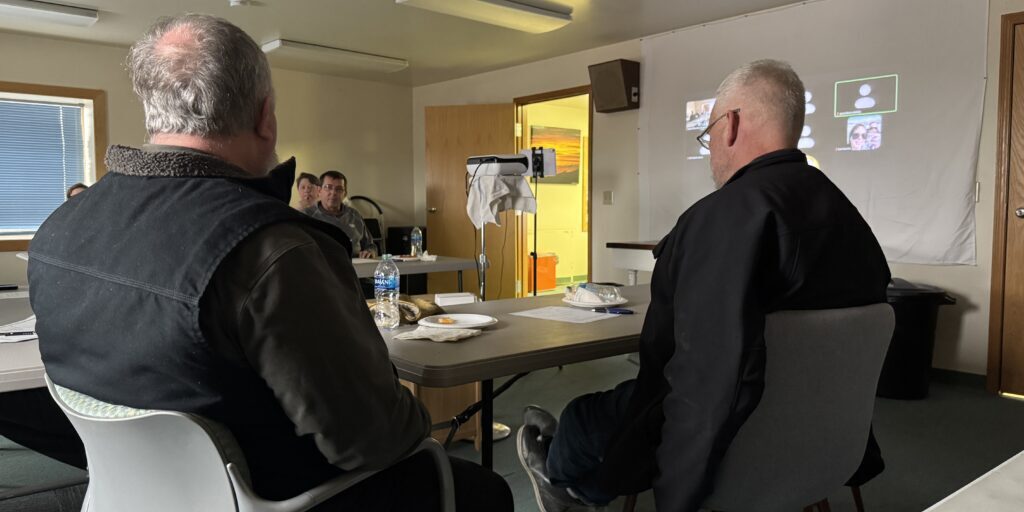Following a three month span that saw at least seven separate encounters with Russian and/or Chinese military ships and planes, Nome’s Local Emergency Planning Committee (LEPC) met with representatives from Senator Dan Sullivan’s office. The committee used the opportunity to question the officials about the merit of designating Nome as a U.S. Department of Transportation Strategic Seaport.
The strategic port designation, if granted, would carry a few stipulations. In the event of a national emergency, the port would need to be made available to the U.S. military in as little as 48 hours. The path toward becoming a strategic port may be a lucrative source of funding for the fledgling project that is set to begin underwater construction next year.
Only 17 cities in the country have earned the strategic seaport designation, with Anchorage being the only other Alaskan city on the list. Anchorage earned the designation in 2004, and has been involved in over 20 deployments of materiel to combat zones like Iraq and Afghanistan.
Defense Policy Advisor for the U.S. Senate, Jimmy Byrn, met with the LEPC via Zoom to discuss the growing geopolitical importance of the Port of Nome. He said that as Russia and China increase their activity in the region, the U.S. needs to reevaluate where its strategic infrastructure is placed.
“A lot of our naval vessels go back to Dutch Harbor in order to refuel. That's, to be frank, a problem for power projection into the Bering Sea and into the Arctic and the Bering Strait as well,” Byrn said.
Nome is over 700 miles north of the Coast Guard’s Dutch Harbor base, making it a good candidate for refueling operations in the Arctic. Once the Port of Nome’s expansion project is complete, it will have the capacity for any size vessel in the Coast Guard’s current fleet.
Byrn stopped short of suggesting that there are any plans in the works, noting that those decisions are typically made at high levels in the military. He noted that Sen. Sullivan has been actively pushing for greater attention to the state’s strategic military role, and it seems that the military is taking notice.
“Nome, I think, is going to be getting a lot of attention from the military, and is already getting some attention from the military in terms of trying to build it out more. I don't have any specific plans. I can always say this, conversations are happening because they recognize that this thing that we put in place is going to be of use to them in the future.”
- Jimmy Byrn, Defense Policy Advisor for the U.S. Senate
Charlie Lean, a member of the LEPC, raised concerns about the need for a stronger U.S. Coast Guard presence to manage increasing incursions into U.S. waters by foreign fishing vessels.
Byrn acknowledged these concerns and elaborated on the broader military implications, explaining that commercial vessels have reportedly been used as cover for military operations, particularly by China in other regions. He stressed that while there’s no current evidence of such activities in the Bering Sea, vigilance is essential.
Byrn also noted that as liquefied natural gas (LNG) deposits on both Russia and Alaska’s northern slopes are exploited, the importance of securing the 50-mile span separating Russia’s Chukchi Peninsula and Alaska’s Seward Peninsula will grow. He said that amidst climate change and receding annual sea ice levels, the route through the Bering Strait is likely to get even busier.
“That area is an area that's going to be very important in the future geopolitically. It makes sense, from my standpoint as a military person, that that would be an area that we would want to have a presence in,” Byrn said.
The issue of local infrastructure was also raised. LEPC Vice-Chair, Paul Kosto, pointed out that Nome’s limited emergency services and medical facilities could struggle to provide care in the event of a “maritime event”.
“We don't really even have the ability on a cruise ship of 200 people to manage that type of an emergency. And if we're going to start having military force projections, and all this commerce that's growing, we have the potential for a maritime event. If they're not thinking about it, maybe they at least need to have a concept of a plan."
- Paul Kosto, LEPC Vice-Chair
Lean suggested to the representatives that the military should at least consider establishing a forward operating base, like Nome has had in the past to maintain White Alice towers and other military assets. Lean emphasized that while Nome is a good candidate for a military presence, implementing the infrastructure will take time.
“I think that Nome is probably the best situated community in western and northern Alaska to support build out,” Lean said. “It's not like walking into a well populated state in the lower 48 and saying, ‘Oh yeah, we're going to add some infrastructure whenever we feel like it’. It's something that will take time, and if you want to do it smoothly, it has to be done incrementally.”
Graphite One’s development to the north of Nome was also discussed as a key national security priority. The critical mineral is currently 100% imported from other countries, with 42% of the U.S.’s imports coming from China. Lightly processed graphite mined at the site would be exported through the Port of Nome to Niles, Ohio, where it would be further refined for commercial use.
The LEPC will reconvene on December 5.





